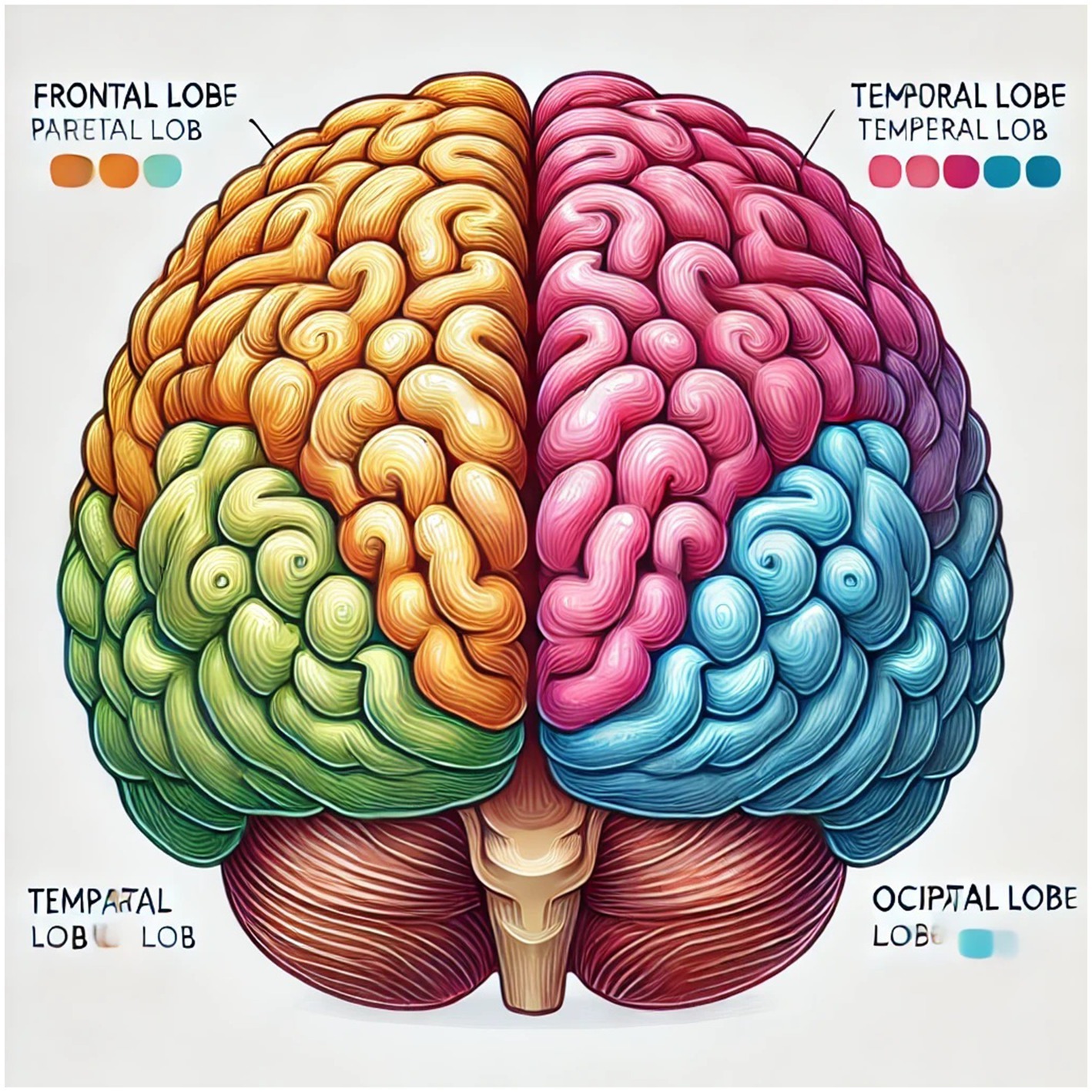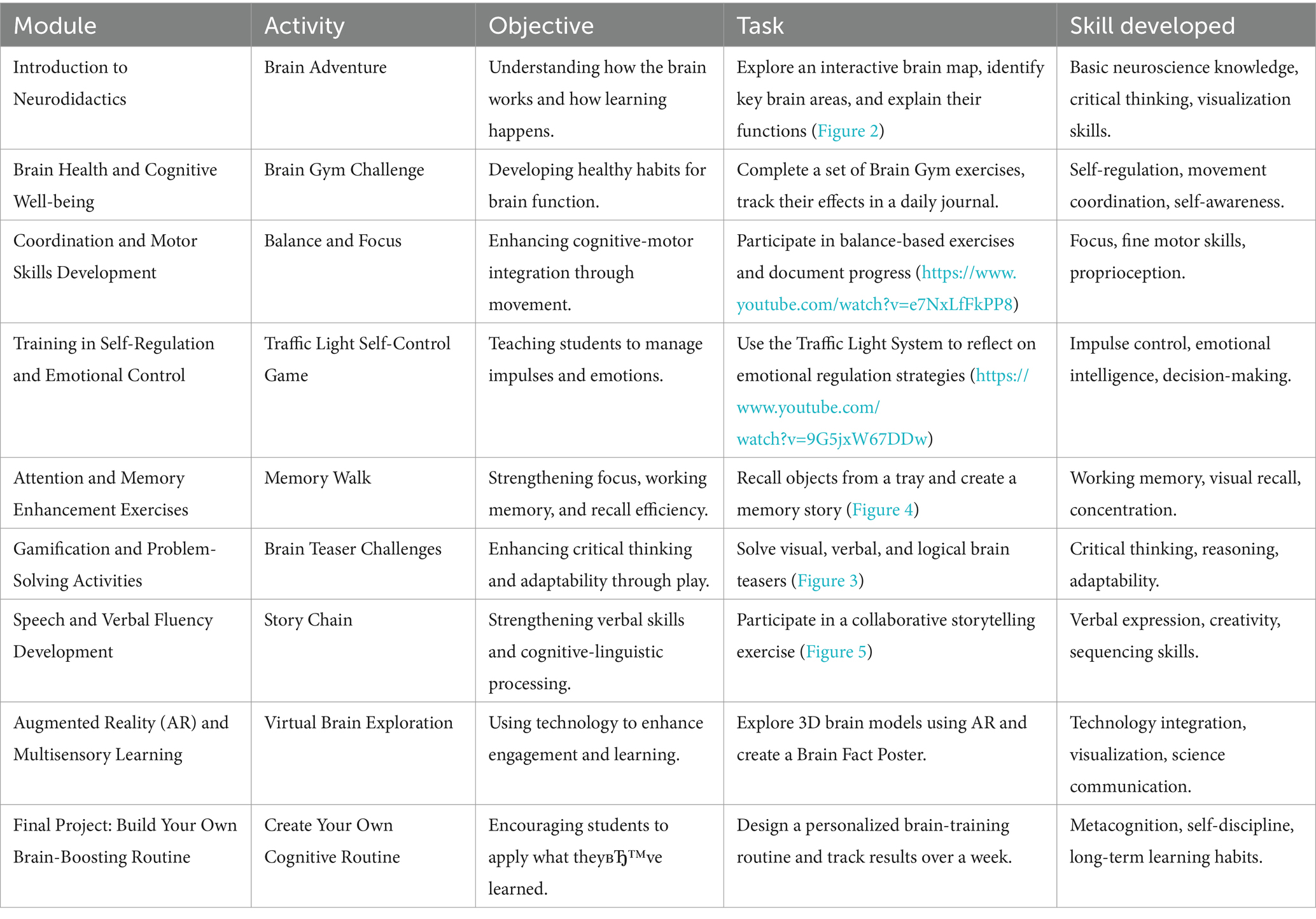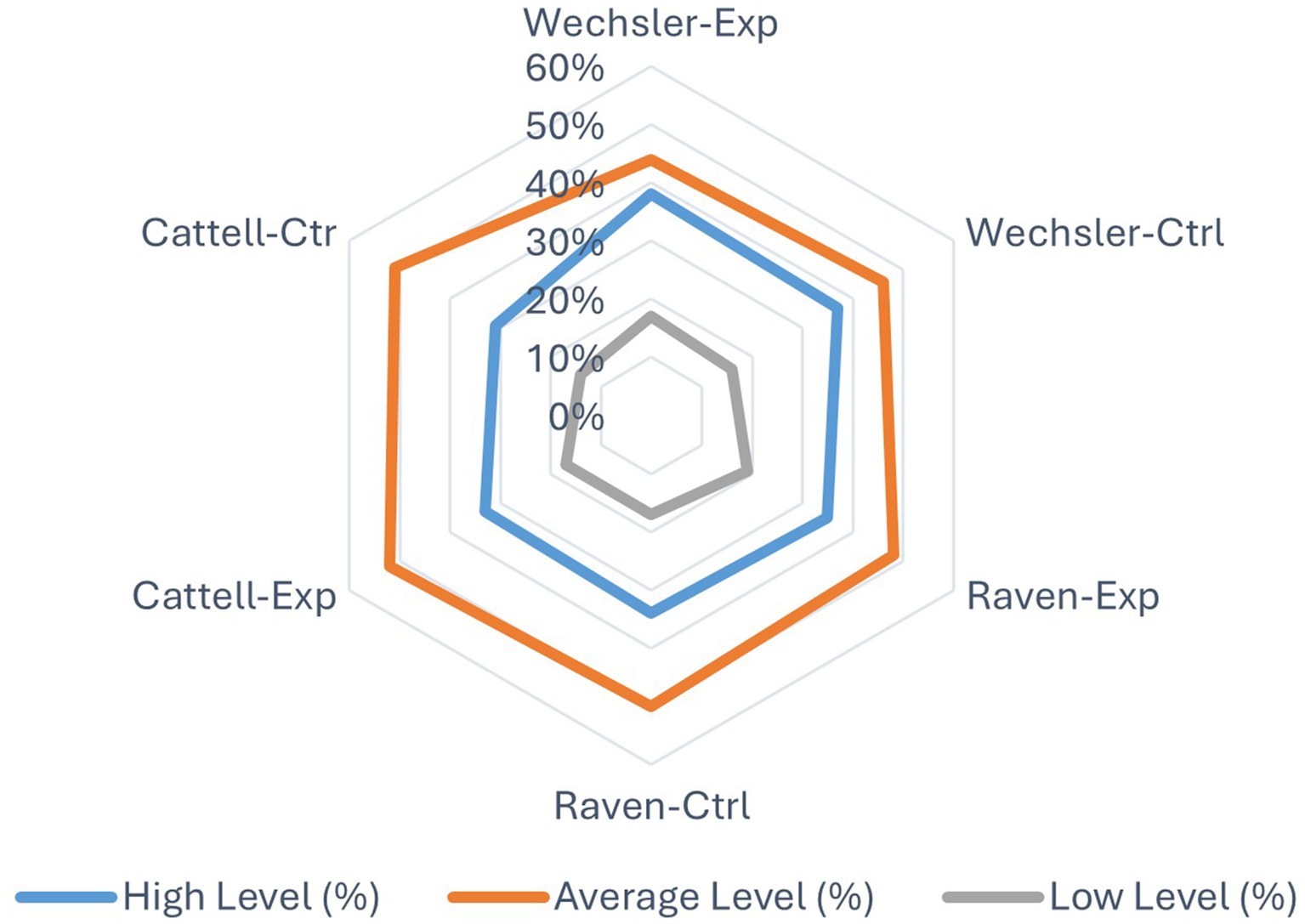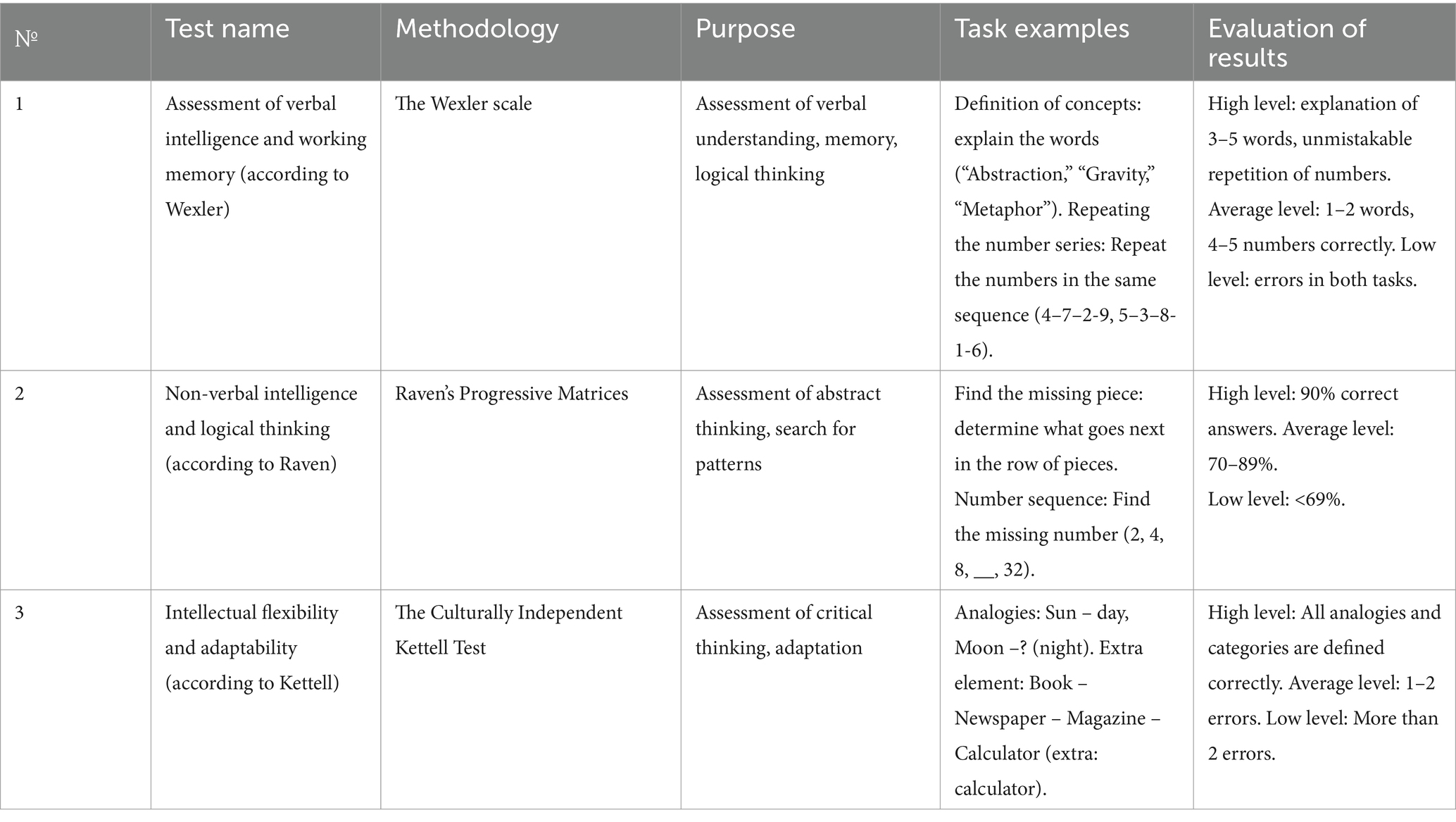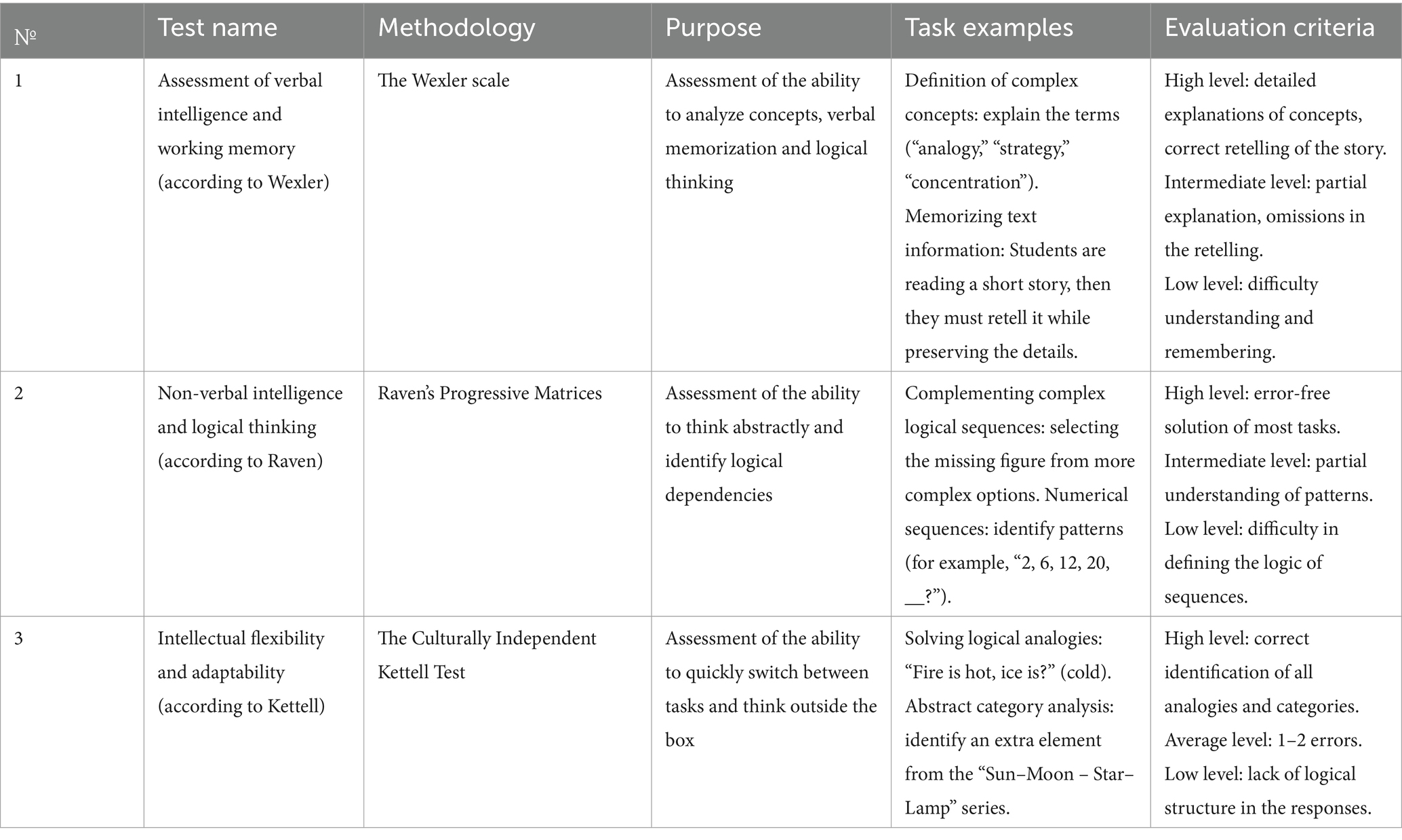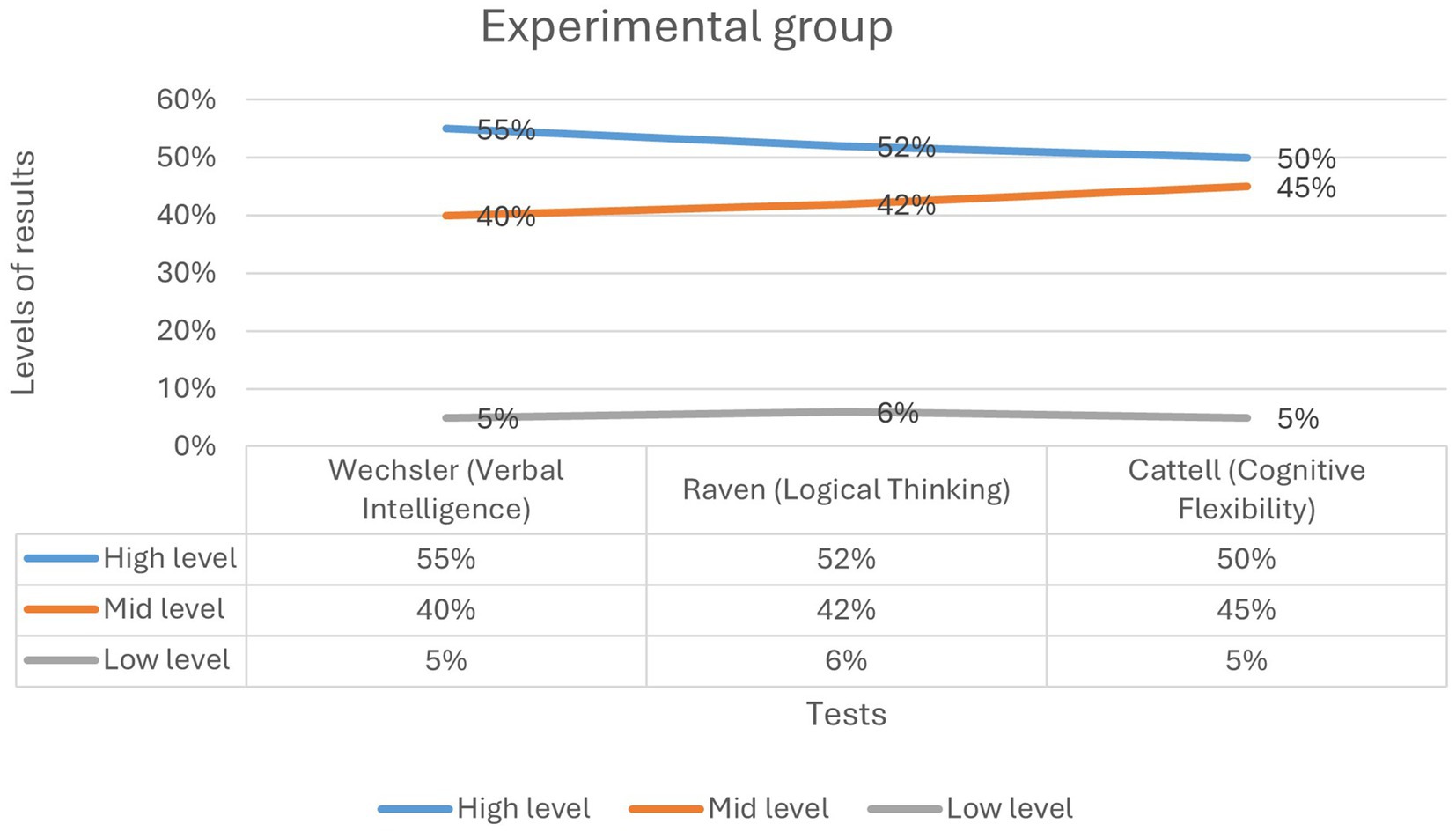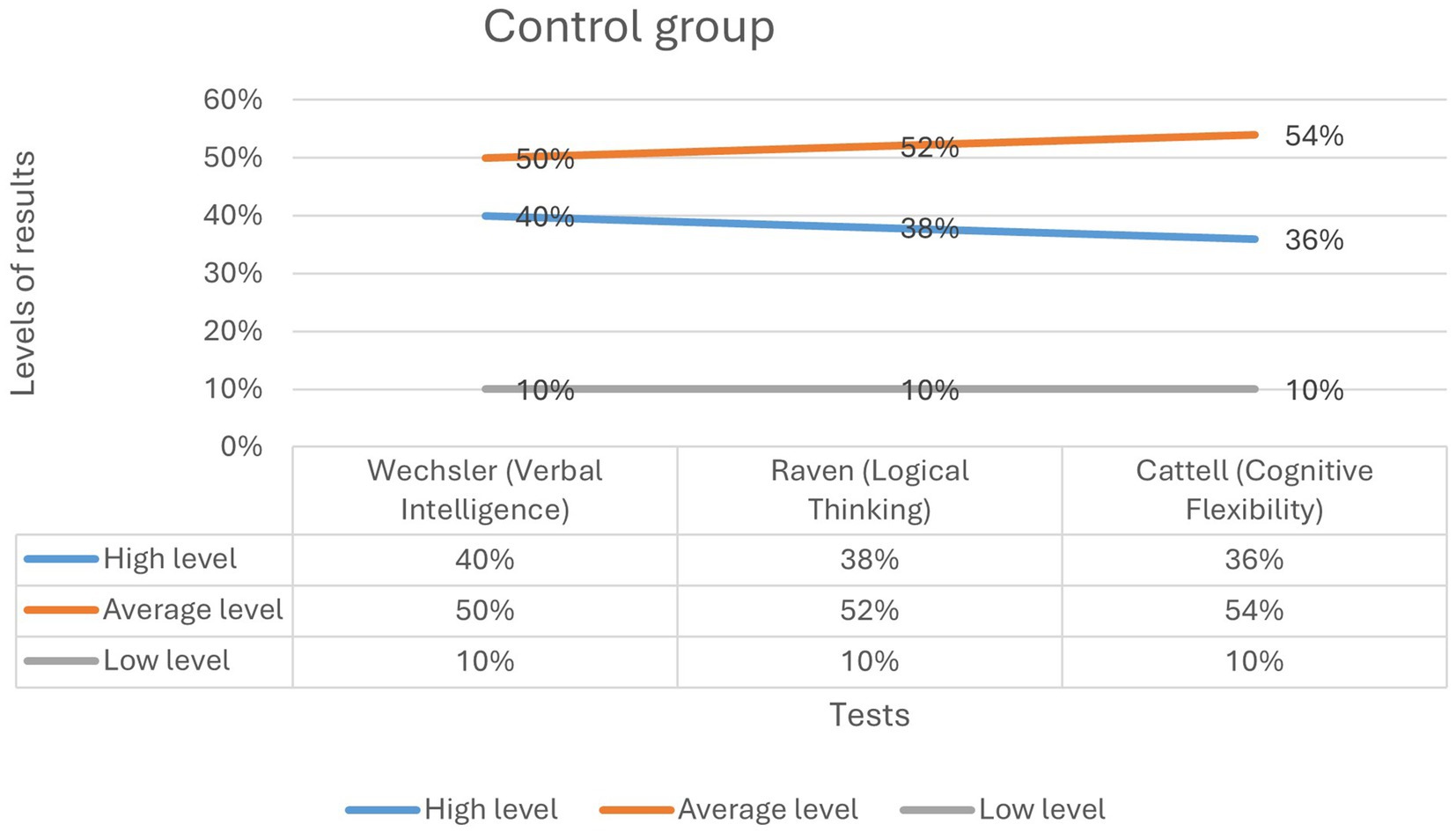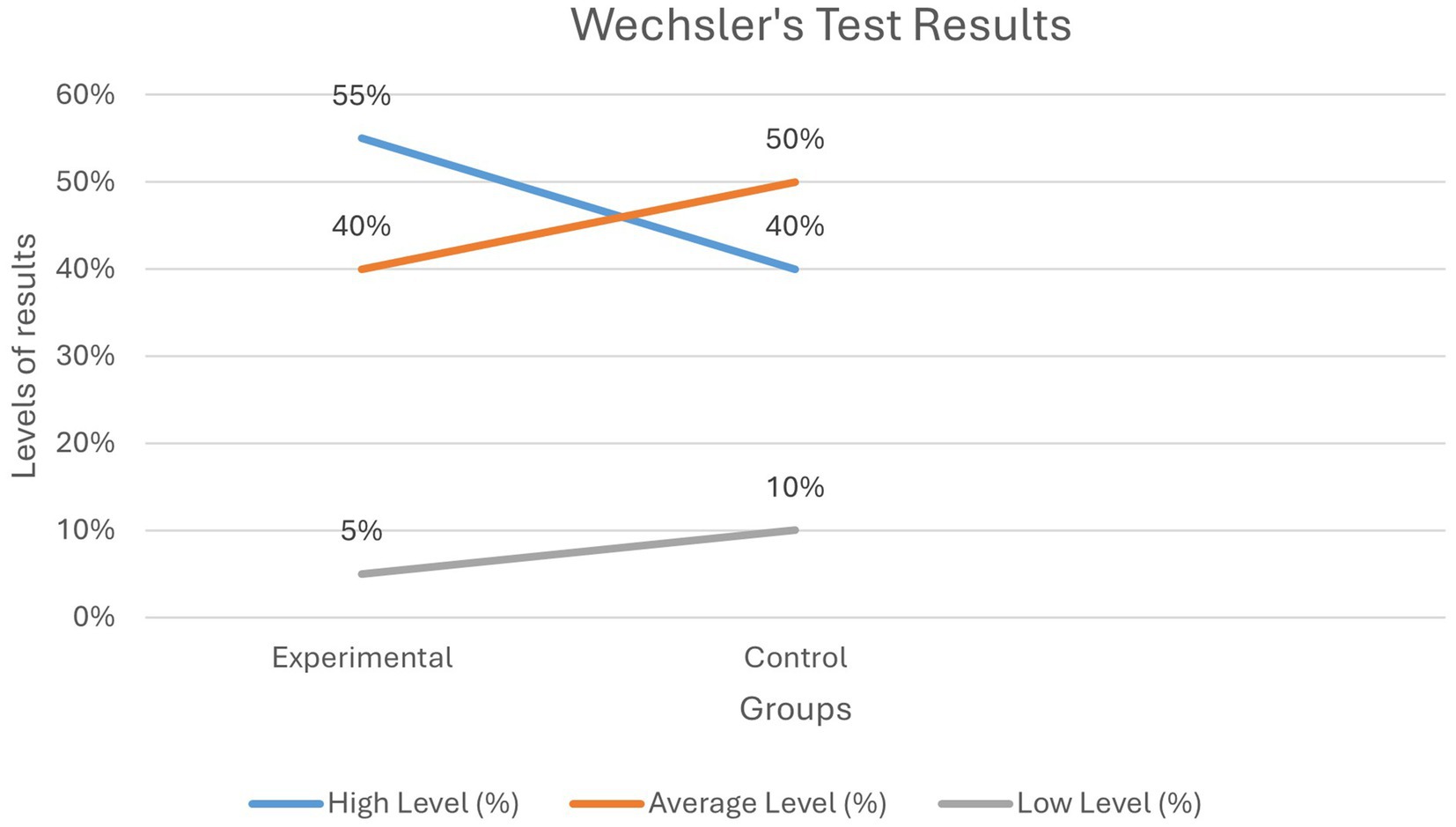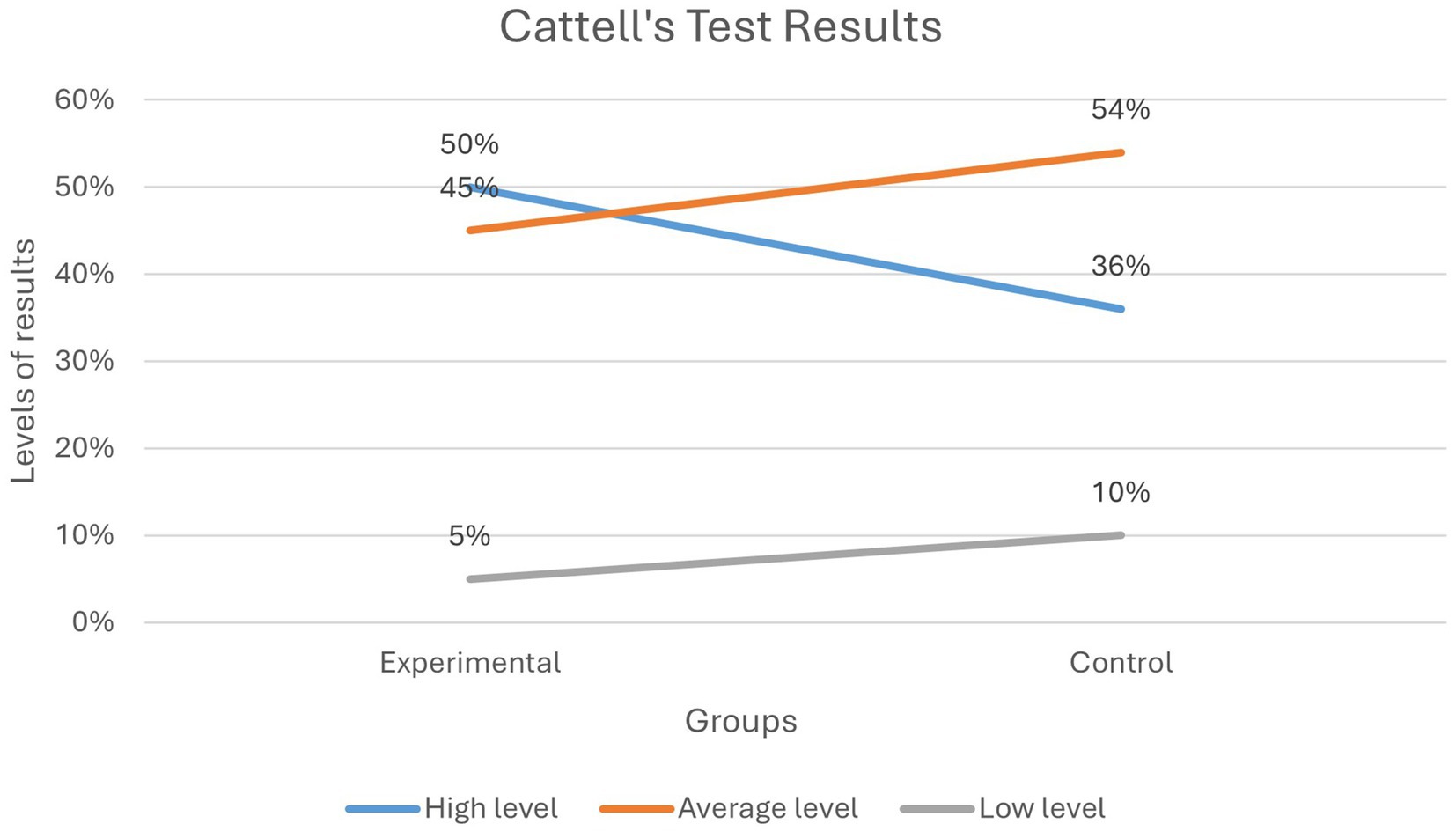- Kazakh National Pedagogical University named after Abai, Almaty, Kazakhstan
Introduction: The increasing integration of neuroscience into education has led to the emergence of neurodidactics, a field that bridges cognitive science, psychology, and pedagogy to enhance student learning outcomes. This study explores the implementation and impact of the elective course “Neurogymnastics,” designed to develop cognitive intelligence, self-regulation, memory, attention, and effective learning strategies among primary school students.
Methods: Approved by the City Scientific and Methodological Center for New Educational Technologies, the course was integrated into the 2024–2025 academic curriculum at School-Gymnasium No. 185 (Alatau District, Almaty) and Ozat School (Auezov District, Almaty). The study was conducted over an academic year, incorporating standardized cognitive testing (Wechsler, Raven’s Progressive Matrices, and Cattell’s Culture-Free Intelligence Test) before and after the intervention.
Findings: The research findings indicate enhancements in abilities among students who took part in the Neurogymnastics program when compared to those in the control group. In the group of students there was an increase in verbal intelligence levels; 55% achieved a high proficiency rating on the Wechsler Test as opposed to 40% in the control group. Likewise significant enhancements were noted in reasoning skills; on the Raven’s Test 52% of students from the group demonstrated high performance compared to only 38%, from the control group.
Discussion: The study has established that neurodidactic interventions improve cognitive abilities, executive function, and self-regulation in young learners. The Neurogymnastics course, which is more engaging and interactive than the traditional teaching methods, was found to be more effective in improving students’ interest and learning retention. The control group had moderate cognitive gains, but the experimental group’s better performance was a clear indication that neuroeducation principles should be incorporated into the regular curriculum to help students become more independent, flexible, and critical learners. The novelty of this study lies in the integration of neurogymnastics with gamification and augmented reality, which creates a complete neurodidactic framework that is specifically designed to improve the cognitive development of primary school students.
1 Introduction
The combination of neuroscience and education has brought about a change in the way students learn and remember information by highlighting the significance of using brain focused learning techniques to enhance growth. This blend of fields has led to the emergence of neuroeducation. An area that blends neuroscience with psychology and teaching methods to develop educational strategies that work in harmony with how our brains learn. Neurodidactics was initially proposed by Gerhard Price back, in 1988. Has developed over the years into a established framework that promotes cognitive adaptability and problem-solving skills among students through enhanced executive functions and memory retention mechanisms. The expanding research in neuroscience emphasizes the effectiveness of neurodidactic methods in improving learning outcomes by stimulating various brain areas responsible, for attention control and information assimilation.
Neuroeducation as a developing field promotes evidence-based methods which follow brain functioning principles to improve learning results (Tokuhama-Espinosa, 2011; Thomas et al., 2019). In the 10 years or so there has been a growing acceptance of neuro-education strategies, in elementary education, where interventions at an early stage can greatly influence cognitive development, self control and the potential for lifelong learning. The early years of a childs life are crucial, for brain development and research shows that specialized cognitive training programs can significantly boost brain plasticity, enhance memory retention processes and sharpen executive function abilities. Conventional teaching approaches that heavily rely on memorization and standardized teaching methods often overlook the nature of growth. On the hand neurodidactic methods make use of sensory learning approaches, like games and activities that stimulate the brain as well, as augmented reality (AR) to craft captivating and personalized learning encounters. Creating interventions grounded in neuroscience techniques allows teachers to not just enhance academic performance but also foster students self awareness adaptability and toughness.
With the growing demand for interventions backed by evidence-based approaches in education settings is the creation of the Neurogymnastics course. This structured program is designed to improve abilities such as memory retention and problem-solving skills while enhancing self regulation and attention control in elementary school students through brain focused learning techniques. Structured interventions targeting executive functions have shown significant improvements in cognitive performance (Diamond and Ling, 2016). The Neurogmynastics course differs from teaching approaches by focusing on engagement and interconnected lesson modules that build upon existing knowledge in a progressive and cohesive manner to enhance cognitive development effectively. It is now part of the curriculum at School Gymnasium No 185 in Alatau District. Also, at Ozat School in Auezov District in Almatu, for the year 2024–2025.
The Neurogymnastics program comprises eight defined sections that target aspects of cognitive and executive function growth. The program kicks off with an overview of neurodidactics to equip students with insights, into how the brain acquires knowledge and processes data. Following units delve into brain wellness and cognitive health by emphasizing the significance of sleep quality, nutrition and physical exercise, in enhancing abilities. Coordination and motor skill enhancement are fostered through neurogymnastics routines designed to boost cognitive motor coordination and improve flexibility. Teaching self regulation and emotional control is key to helping students handle their impulses better and improve their executive function skills overall. The exercises, for enhancing attention and memory aim to boost focus levels and memory recall efficiency for students to develop processing techniques. Incorporating gamification and problem-solving tasks helps foster thinking skills alongside creativity and adaptive learning approaches. Engaging in speech practices can boost speaking skills and language comprehension, for learners by improving communication abilities and cognitive functions positively impacted by the use of augmented reality (AR). Additionally utilizing multisensory educational tools facilitates creating captivating learning encounters that stimulate involvement and improve memory retention, in the run.
The Neurogymnastics program consists of 45-min training sessions spread out over four terms to offer a balanced and adaptable approach, to cognitive improvement skills development with sustained student involvement at a peak level of interest and interaction. In contrast to teaching techniques that lean towards learning via direct guidance and instruction methods usually seen in traditional educational settings; the neurodidactic model focuses on active participation from students, through hands on experiences and cognitive exploration activities. By employing interventions that incorporate sensory experiences simultaneously; students can strengthen their neural connections leading to improved comprehension and enhanced cognitive flexibility.
With the growing influence of neuroscience, on methods in mind this research project sets out to thoroughly assess how well the Neurogymnastics course supports the development of cognitive abilities and self regulation skills in young students. Studying is driven by a number of goals. One aim is to pinpoint and examine the concepts integrated into the Neurogymnastics syllabus to gauge their effects on student involvement and cognitive capabilities. The second objective of the study is to assess how neurodidactic interventions impact skills such as attention control and problem-solving abilities in students cognitive development from both experimental and control groups to determine notable enhancements in neurophysiological performance and validate the effectiveness of the Neurohymnastics approach, with empirical evidence. The aim of this study is to evaluate the impact of the Neurogymnastics course on cognitive development in primary school students.
This study adds to the areas of neuroscience and educational research by providing real world insights into how structured neurodidactic methods impact elementary education positively. The results of this research will help advance models based on neuroscience principles and show how neurodidactic approaches can enhance learning and promote adaptability. Furthermore, the study holds real world significance by offering suggestions, for including neurodidactic materials in school curricula to enhance student learning results and boost cognitive flexibility while encouraging adaptive learning strategies. Through an evaluation of the effectiveness of the Neurogymnastics course this research lays down groundwork, for future studies in neuroeducation emphasizing the necessity of integrating neuroscience and pedagogical practices to establish more efficient and student focused learning settings.
The study of neurodidactics has become a field that combines neuroscience with cognitive psychology and teaching methods to improve how students learn effectively. In recent years, research in neuroscience has shown that implementing strategies that align with how the brain learns and retains information can greatly boost students’ cognitive abilities. This review of literature explores the theories and research findings that support the application of neurodidactic methods in elementary education, with a focus on cognitive growth, self-control, memory improvement, and managerial skills enhancement.
Neurodidactics as a scientific field combines cognitive neuroscience, educational psychology, and new pedagogical technologies. The main purpose is to create smart learning strategies that can be tailored to the brain’s complexity and plasticity, and which can also be used to improve cognition. Thus, as Pathak and Verma (2024) argue, it is possible to enhance the efficacy of teaching and learning based on the principles of neurodidactics. This is because by knowing how the brain works, teachers can teach students in ways that would help them store information, think critically and solve problems. Neurodidactics focuses on experience-dependent learning, which means that the more we expose ourselves to certain information and repeat the process, the more the neural pathways are strengthened, leading to better learning. Social cognitive systems are an essential part of modern educational technologies. Quadros and Pacífico (2024) found that cooperative learning, which includes students’ meaningful engagement, enhances the retention of information and critical thinking skills in the long run. This approach encourages a deeper engagement with content through group discussions and collaborative learning, activating different parts of the brain associated with social cognition and complex thinking. Increasingly, the problem of controlling mind wandering—a frequent occurrence in the classroom—has become important. Graham et al. (2024) showed that cognitive training interventions can improve students’ attention and self-control, which in turn leads to better academic achievement. These interventions are designed to help students concentrate, ignore distractions, and sustain interest in learning activities. Illapa (2024) established that cognitive training based on neurodidactic principles is beneficial for short-term memory and executive functions. This research emphasizes the benefits of cognitive learning strategies, through systematic cognitive exercises, in assisting students to better receive and process information. The research of Hernández and Fragoso (2024) shows that pedagogical strategies in language learning which focus on attention and working memory lead to substantial improvements in long-term retention of vocabulary and grammatical structures, which supports the importance of executive function training in neurodidactic approaches to foreign-language instruction. The use of Electroencephalography (EEG) technologies in foreign language learning has revealed that optimizing cognitive load enhances long-term memory significantly (Zhu, 2024). By monitoring neural activity during learning, researchers can determine the optimal conditions for minimizing cognitive overload and maximizing retention. EEG studies demonstrate that manipulating working memory load in real time can enhance the encoding of linguistic structures and improve recall. Additionally, Zakharova and Lizunkov (2024) examined neurodidactic strategies in professional education and found that neuroeducational technologies enhance creative thinking. Their study showed that integrating cognitive stimulation strategies into skill-based training programs improves problem-solving skills and adaptability within workplace environments.
Executive functions, such as cognitive flexibility, self-regulation, and attention, are key predictors of successful learning outcomes. Pradeep et al. (2024) established that cognitive training interventions aimed at improving self-regulation significantly enhance students’ capacity for attention and memory retention. These training programs strengthen functions of the prefrontal cortex involved in impulse control and working memory, which are crucial for learning. Pavlovskienė (2024) found that multimodal learning, integrating visual, auditory, and kinesthetic learning styles, is more effective for foreign language acquisition than using any single modality alone. Combining these sensory modalities enhances the neural processes involved in language comprehension, leading to faster and more accurate language learning. The integration of artificial intelligence (AI) and machine learning is transforming adaptive learning platforms. Shiwlani et al. (2024) confirmed that AI-based educational technologies enable the development of personalized learning plans, allowing students to learn at their own pace and receive immediate feedback. Such AI-driven models can detect learning difficulties and dynamically adjust the content, significantly enhancing the overall effectiveness and productivity of educational systems. In the study by Díaz-Cabriales (2025), cognitive technologies were found to enhance neural processing efficiency, thereby helping students learn complex mathematical concepts. Their research shows that neuroscientifically informed instructional design can improve students’ problem solving and logical reasoning abilities. In her dissertation, Martínez García (2024) explained that incorporating neuroeducational strategies with pedagogical technologies guarantees the development of highly individualized educational programs tailored to each student’s cognitive profile. Some of these strategies include adaptive testing, cognitive scaffolding, and real-time learning analytics. In the context of Industry 5.0, Rueda-Castro et al. (2024) explored the neurobiological aspects of learning and discussed psychophysiological mechanisms underlying cognitive development. Their results also demonstrated the potential of brain-computer interface (BCI) applications in education, providing direct feedback on cognitive engagement and performance. Lebedeva (2024) pointed out that the transition to neuroeducational models requires substantial improvements in teacher training and the establishment of new educational standards. Therefore, optimal learning conditions demand educators trained in neuroscience-informed instructional practices, ensuring scientifically validated teaching methods.
In the study by Pujals et al. (2024a), cognitive strategies were most effective when implemented at an early age, significantly enhancing academic performance in childhood education. As further stated by Pujals et al. (2024a), early childhood is the optimal period for interventions due to high neuroplasticity. Torres Bravo (2024a) investigated the role of emotional intelligence within educational strategies, finding that neurodidactics effectively develops socio-cognitive skills. Emotional intelligence training in education increases resilience, empathy, and self-awareness—qualities essential for both academic and personal development. Sharma and Kumar (2024) concluded that mindfulness practices such as meditation and neuro-conscious learning benefit cognitive functions. Barraza (2024) established that integrating neuroscience-based techniques into teaching enhances student motivation and classroom attendance. This study emphasized the importance of brain-based learning strategies for improving attention, memory, and knowledge transfer. In debunking common neuromyths, Howard-Jones (2014) advocated for scientifically validated educational strategies. Similarly, Goswami (2021) systematically reviewed the literature on brain development and learning, stressing the need for structured approaches in neuroeducation. The findings underscored that early cognitive training can significantly influence a child’s learning trajectory and future educational outcomes. Sousa (2017) highlighted that a general understanding of brain functioning is crucial for designing effective teaching strategies. Goswami (2004) states that early cognitive training based on brain development principles can significantly enhance learning outcomes and determine future educational paths. Linking educational interventions to neural mechanisms results in enhanced instructional quality and improved learning outcomes. One integral part of neurodidactics is Cognitive Load Theory, which remains influential in neuroeducational practices today (Sweller et al., 2011). This theory deals with cognitive complexity and emphasizes managing cognitive load effectively for optimal learning. Reducing extraneous cognitive load while intentionally enriching germane cognitive load facilitates meaningful learning. McClelland et al. (2001) provided evidence regarding the impact of neuroeducation on cognition, illustrating how the interplay between environmental and genetic factors shapes learning abilities. Their findings support the long-term efficacy of structured cognitive stimulation, emphasizing interactions between cognition, experience, and neural plasticity. Additionally, Torres Bravo (2024b) examined the effects of neurodidactic strategies on student motivation in higher education, revealing that neuroeducational approaches significantly improve cognitive learning strategies. The integration of brain-based learning strategies into university curricula thus increases student engagement, academic achievement, and metacognitive awareness. Finally, Pujals et al. (2024b) reinforced that integrating neuroeducation, digital technologies, and adaptive teaching methods remains crucial within contemporary educational theory. Their work contributes to the continuous evolution of individualized teaching methodologies grounded in neuroscientific evidence.
The study maintains its importance since educational institutions need evidence-based teaching methods that follow cognitive neuroscience principles. The current educational landscape requires neurodidactic methods because traditional teaching methods do not properly support individual cognitive differences, so these approaches provide innovative solutions to improve learning efficiency, self-regulation and critical thinking. The combination of neurogymnastics with gamification and augmented reality addresses contemporary educational problems by developing student engagement while promoting adaptability and cognitive flexibility. The research advances neuroeducation theory while developing practical implementation methods for primary education that support both typical and atypical development needs while requiring contextual adjustments for different cultural and institutional settings. In the study group consisting of 312 students were engaged in a training program called Neurogymnastics aimed at improving various cognitive functions using proven learning methods based on scientific research findings. On the other hand, the control group of 312 students followed their curriculum as usual serving as a reference point, for comparison, without any neurodidactic interventions. In order to make sure that the study is trustworthy and dependable participants were chosen according to these criteria; students had to be aged between 7 and 10 years old (in grades 1–4) possess cognitive abilities (evaluated through cognitive tests conducted before the study) not have any known neurological or cognitive issues and have received written permission, from their parents to take part in the study. The study was conducted in accordance with the ethical standards of the institutional research committee and the 1964 Helsinki declaration. Ethical approval was granted by the City Scientific and Methodological Center, for New Educational Technologies (Approval No. 6). The research followed established neuroscience research guidelines (Illes and Bird, 2006) and included ethical considerations for child assent.
2 Materials and methodology
2.1 Data collection
The study involved a three-phase experiment to assess enhancements in the short and long term throughout the academic year. In the stage of diagnosis, at the start of the school year evaluations were carried out to establish a measure of students cognitive abilities. The following standardized intelligence tests were administered to all participants:
Wechsler Intelligence Scale – assessing verbal comprehension, working memory, processing speed, and logical reasoning.
Raven’s Progressive Matrices – evaluating non-verbal reasoning, pattern recognition, and problem-solving abilities.
Cattell’s Culture-Free Intelligence Test – measuring fluid intelligence and cognitive adaptability.
These assessments provided a reference point for comparative analysis, ensuring that any observed cognitive improvements could be attributed to the neurodidactic intervention rather than natural cognitive maturation.
During the formative stage, the Neurogymnastics elective course was integrated into the experimental group’s curriculum, following a spiral learning model where interconnected lesson topics progressively built upon prior knowledge. The program consisted of weekly 45-min training sessions delivered over four academic terms, incorporating multiple scientifically grounded neurodidactic methodologies. These included:
1. Neurogymnastics and coordination exercises to promote cognitive-motor integration and enhance neural plasticity.
2. Attention and memory enhancement techniques aimed at improving sustained focus, working memory, and recall efficiency.
3. Self-regulation and impulse control training, fostering executive functioning, emotional regulation, and adaptive learning strategies.
4. Gamification-based cognitive learning, integrating interactive problem-solving activities to increase engagement and motivation.
5. Augmented reality (AR) and multisensory learning materials to create immersive and interactive neurodidactic experiences.
6. Speech development exercises to strengthen verbal fluency, articulation, and linguistic processing.
Throughout this phase, the control group continued their education using traditional instructional methods, allowing for a comparative baseline assessment of how neurodidactic strategies influenced cognitive performance.
At the control stage, conducted at the end of the academic year, students underwent post-intervention cognitive testing, using the same diagnostic instruments as in the initial assessment. The primary objective of this final phase was to measure cognitive development in key areas, including memory retention, executive function, self-regulation, attention span, verbal reasoning, and problem-solving abilities.
2.2 Data analysis
After examining the outcomes of the study; various statistical techniques such as T tests and ANOVA were utilized to pinpoint variances in and post intervention evaluations successfully employed for this analysis. The results indicated an enhancement in functions within the group that underwent the experiment; specifically showing progress in executive functioning abilities along with memory retention and attentional control. Thereby confirming the positive impact of structured neurodidactic interventions on augmentative cognitive skills, among young students. The studys long term approach confirmed that these enhancements persisted over time and showcased how neurodidactic strategies can aid in the advancement of skills and problem-solving abilities, in elementary education. The analysis included both significance testing and effect size calculations using Cohen’s d to determine the magnitude of cognitive improvements. The statistical outcomes received Bonferroni correction to maintain their robustness and reliability when dealing with multiple comparisons (see Figure 1).
2.3 Materials
Implementing methods in education involves creating well planned learning materials based on research that resonate with the fundamentals of cognitive neuroscience and developmental psychology while incorporating best teaching practices. In this research project on the Neurogymnastics course for primary school students aimed at boosting growth through a structured cognitive training regimen combining multisensory learning techniques with neurogymnastics activities and engaging educational strategies such as gamification and augmented reality (AR). The creation of materials for the study was based on the recent progress in neuroscience and education to make sure that the learning materials were backed by science and suitable, for different age groups and learning styles.
The main goal of designing materials was to develop activities that are exciting and immersive while enhancing memory retention and problem solving skills as well, as verbal fluency through interactive tasks that require active participation and cognitive flexibility unlike traditional educational materials that emphasize memorization and passive learning the neurodidactic resources created for this study were designed to encourage engagement critical thinking and brain activity by incorporating real life problem solving challenges and engaging educational experiences.
The strategy for progress was based on a learning method that gradually introduced ideas in an organized way to enable students to enhance their existing skills incrementally. Tailored neuroeducational materials were designed for varying abilities among children aged 7–10 years old to ensure that all students could engage in age cognitive tasks. In addition, to this approach the educational content was thoughtfully selected to encompass hands on activities, interactive learning tools and digital materials. All aimed at enhancing student involvement and information retention.
As shown in Table 1 the educational materials designed for this study included a range of elements such, as worksheets for training tasks and activities to improve attention span and mental agility exercises like neurogymnastics routines and immersive storytelling experiences that engage senses, alongside educational games and interactive simulations using augmented reality technology These resources were incorporated into the weekly curriculum of the Neurogymnastics class to enable students to participate actively in organized educational activities throughout the school year.
This part offers a summary of the framework used to design educational materials for the study focusing on neuroscience and education techniques to improve early cognitive development and academic achievements, in primary school settings by explaining their scientific basis and teaching effectiveness.
Figure 2 provides the visual aid with an interactive way to delve into the intricacies of brain anatomy and function; it helps individuals recognize areas and grasp their functions effectively by fostering critical thinking skills and deepening understanding of foundational neuroscientific concepts.
Engaging in this activity (Figure 3) of spotting the differences boosts ones ability to distinguish visually and focus on details while enhancing processing, by challenging individuals to pinpoint variations, between images. It fosters adaptability and critical thinking skills while aiding in the development of observational abilities.
Engaging in the task shown in Figure 4 can boost memory retention and cognitive skills while also enhancing storytelling abilities as individuals are prompted to observe details and reconstruct them from memory.

Figure 4. Speech and verbal fluency development (free access https://in.pinterest.com/pin/209417451399491386/).
Figure 5 shows a group storytelling activity that helps improve speaking skills and creativity by encouraging storytelling and cooperative learning to enhance communication and critical thinking abilities.
3 Results
3.1 Baseline cognitive assessment
The study group utilized custom neuro materials designed for enhanced learning experiences. The class sessions were structured to incorporate engaging activities focusing on improving concentration, memory retention and cognitive abilities. To kick off each lesson session various tasks were assigned to engage functions through activities, like attention stimulating games or exercises involving auditory prompts. The core segment of the class was dedicated to completing tasks that involved modes of stimulation encouraging both creative thinking. The lessons concluded with a session, where students shared their thoughts and feelings, about the activities undertaken and discussed the outcomes achieved.
As part of the study of the effectiveness of the elective course “Neurogymnastics,” a primary diagnosis of cognitive abilities was carried out among 624 students of two schools in Almaty: Gymnasium School No. 185 (Alatau district) and the private school “Ozat School” (Auezovsky district). Table 2 illustrates assignments which were included within the initial diagnosis of the research. The main purpose of the diagnosis was to determine the initial level of cognitive development of students, which would subsequently assess the impact of neurodidactic methods on the dynamics of their intellectual growth. The study included comprehensive testing based on internationally recognized methods for measuring intelligence: the Wexler scale, the Raven progressive matrices, and the culturally independent Cattell test.
The study involved two sets of students – a group of 312 individuals who were scheduled to undergo training, in neurodidactics techniques and a control group of 312 students who followed the educational curriculum without any modifications made to their learning process. Throughout the assessment phase of the studys protocol covered three domains – aptitude and memory recall capabilities; critical thinking skills and the ability to analyze patterns; as well, as cognitive flexibility and adaptability when faced with novel intellectual challenges. The Wexler scale was employed to evaluate intelligence and the capacity for analyzing concepts and quickly memorizing information; Ravens progressive matrices enabled assessment of thinking levels and identification of logical patterns and sequences; The Cattell test facilitated measurement of cognitive flexibility levels and adaptability, to evolving circumstances.
Figure 5 presents the initial cognitive assessment results, showing the classification of students’ performances into high, average, and low-level categories. The students underwent evaluations in three domains; verbal intelligence and memory (measured using the Wechsler test) logical reasoning and pattern recognition (assessed through the Ravens test) and cognitive flexibility and adaptability (evaluated with the Cattells test). Their performances were classified into high, average and low-level categories.
Based on the data findings provided in the study, for both sets of students analyzed suggest that most students fall within the range in all tests taken indicates that they have cognitive abilities but also highlights areas where they can enhance their performance further. In the Wechsler test focusing on language skills and memory retention aspects of intelligence assessment revealed that 38% of students in the group and 37%, in the control group achieved high scores while approximately 45–46% attained average scores. 17% of students encountered challenges, with assignments which suggest that the majority possessed a capacity to comprehend and remember spoken information.
In the Ravens test we saw a trend where students showed their reasoning skills and ability to spot patterns. The proportions of performing students were a tad less. 35%, in the experimental group and 34% in the control group. With a larger chunk falling into the average bracket at 48 to 50%. This indicates that while students can pick up patterns enough some might find it challenging when it comes to dealing with more intricate abstract reasoning tasks. This signifies an opportunity for tailored cognitive training interventions.
Cognitive flexibility and adaptability seemed to be the aspect according to the Cattell test results, for students in both the experimental and control groups. Among the students assessed in this area; about 33% in the group and 32% in the control group demonstrated a high level of proficiency while a majority of around 50–51% fell within the average range. The smaller percentage of students performing at the level suggests that many struggle with adjusting to cognitive tasks. This indicates a need for interventions that focus on improving their problem-solving abilities and cognitive flexibility.
The results show that both sets of participants had abilities at the beginning of the study which allows for a fair assessment of the effects of neurodidactic interventions on the experimental groups cognitive skills. The data also suggests that students generally have abilities but may need extra help in certain areas like logical reasoning and cognitive flexibility. Moving ahead with the research project; The experimental group will receive training that includes multisensory learning approaches and activities such as neurogymnastics and gamification, with augmented reality technology; whereas the control group will stick to conventional teaching methods. The outcomes of the assessments conducted after the intervention will offer an insight into the effectiveness of techniques, in improving memory retention skills and critical thinking abilities to assess if brain based educational methods can provide greater cognitive advantages, over traditional teaching methods.
Data analysis allows us to draw several key conclusions. Firstly, a significant number of students have the potential to effectively master neuro-didactic techniques, since their basic cognitive skills are developed at a sufficient level. Secondly, the high percentage of students who are at an average level on all tests indicates the need to strengthen educational strategies aimed at developing attention, memory and logical thinking. Thirdly, the identified group of students with low results needs specialized pedagogical approaches, including individual work on the development of memory, concentration and flexibility of thinking.
The data obtained will form the basis for further research aimed at assessing changes in students’ cognitive development after completing the Neurogymnastics course. The final diagnosis, scheduled for the end of the academic year, will determine the degree of effectiveness of neurodidactic methods in comparison with the traditional teaching system. Thus, the study not only confirms the relevance of the introduction of neuro-didactic technologies in the educational process but also offers practical recommendations for optimizing educational programs based on the analysis of cognitive characteristics of students.
After completing a full cycle of training in the elective course “Neurogymnastics,” a secondary diagnosis of the cognitive abilities of the students who participated in the experiment is carried out during the school year. The purpose of this stage of the study is to evaluate the dynamics of cognitive function development in children aged 7–10 years after the introduction of neurodidactic methods and to identify their effectiveness in comparison with traditional educational approaches.
3.2 Second diagnostic methodology
As in the first stage of the study, the diagnosis is carried out in three key areas, using adapted versions of tests based on:
The Wechsler Intelligence Scale (Wechsler Intelligence Scale) – assessment of verbal intelligence, memory, logical thinking and information processing speed.
Raven’s Progressive Matrices – a measurement of abstract thinking, pattern analysis, and nonverbal intelligence.
Cattell’s Culture-Free Intelligence Test - diagnostics of cognitive flexibility, adaptability and ability to solve non–standard tasks.
The main difference between secondary diagnostics and primary diagnostics is the complication of some tasks, which makes it possible to identify the progress of students and determine the impact of the Neurogymnastics course on the development of their intellectual skills. The post-intervention assessments used more complex tasks than baseline diagnostics to measure students’ ability to use their acquired cognitive skills in solving advanced problems.
As shown in Table 3, secondary diagnostics of students’ cognitive abilities were conducted after completing the Neurogymnastics course to assess the dynamics of intellectual development and evaluate the effectiveness of the implemented neurodidactic techniques. To ensure the objectivity and reliability of the data obtained, the testing procedure was organized under the same conditions as at the stage of the primary diagnosis, which allowed for a correct comparison of the results before and after the course.
Testing included all students who participated in the first stage of diagnosis, which eliminated possible statistical deviations and increased the reliability of conclusions. The test tasks remained the same, but their complexity was increased, which made it possible to evaluate not only the assimilation of previously proposed techniques, but also the ability of students to apply acquired skills in more complex cognitive tasks. This turned out to be especially important for determining the level of development of such key functions as verbal intelligence, the ability to analyze patterns, logical thinking, the flexibility of intelligence and the speed of information processing.
3.3 Comparison of experimental and control groups
After the testing, the students’ results were processed and analyzed, followed by division into three categories. Students who successfully completed more than 80% of the tasks were classified as having a high level of cognitive development, which indicated significant progress in mastering the course material. Those who completed some of the tasks but made mistakes in the more complex elements of the test were classified as intermediate. Students experiencing significant difficulties in completing most of the tasks were classified as having a low level of cognitive development, which indicated the need for further study of their individual difficulties and the search for additional corrective techniques.
After classifying the participants, the average scores obtained at the secondary diagnostic stage were compared with the results of the primary testing. This made it possible to quantify the degree of changes that occurred in students’ cognitive abilities after completing the course. The increase in the average score among the study participants was an objective confirmation of the effectiveness of the Neurogymnastics program in the development of cognitive functions.
Particular attention was paid to the quantitative changes in the distribution of students by levels. An increase in the number of students who achieved a high level testified to the positive impact of the course on intellectual development, while a decrease in the proportion of students with low results confirmed that the use of neurodidactic methods contributed to the improvement of cognitive abilities even among those who previously had significant learning difficulties.
Before conducting inferential statistical analyses, the dataset was examined for normality and homogeneity of variance. Mean scores and standard deviations were calculated for each cognitive test (Wechsler, Raven, Cattell) at both the pre-test (baseline cognitive assessment) and post-test (after the intervention) stages.
Paired t-tests (Within-Group Comparisons).
To determine the extent of cognitive improvements within each group, paired t-tests were applied:
Experimental Group (n = 312):
Wechsler Intelligence Scale (Verbal Intelligence, Working Memory): t (311) = 27.18, p < 0.001 → Significant improvement in verbal intelligence.
Raven’s Progressive Matrices (Logical Thinking, Pattern Recognition): t (311) = 24.85, p < 0.001 → Notable enhancement in logical reasoning.
Cattell Culture-Free Intelligence Test (Cognitive Flexibility, Adaptability): t (311) = 22.73, p < 0.001 → Considerable progress in cognitive flexibility.
Figure 6 illustrates the improvements observed in the experimental group across all three cognitive domains. The results indicate significant gains in verbal intelligence (Wechsler), logical thinking (Raven), and cognitive flexibility (Cattell) after the implementation of neurodidactic training. The results underscore the impact of the Neurogymnastics program, on students intellectual growth and cognitive skills enhancement. There has been a rise in the number of achievers in all assessments – 55% performed well in Wechsler tests 52% excelled in Raven tests and 50% in Cattell tests. This progress suggests that the educational interventions effectively bolstered students understanding of language ability, for thinking and readiness to tackle cognitive obstacles. The proportion of students scoring poorly on tasks has notably dropped to a 5–3% indicating an improvement, in their cognitive abilities and information processing skills following structured neuroeducation activities since the initial assessments where higher percentages were noted.
Around 40–45% of students are found in the range when it comes to skills, like reasoning and cognitive flexibility; this group seems quite stable and could benefit from personalized help or extra practice to improve their cognitive abilities further The progress seen in cognitive skills supports the value of neurodidactic training and its positive impact, on higher level thinking and problem solving skills. Advancements, in the Wechsler assessment show improvements in understanding language and remembering information over time; whereas outcomes from the Raven test demonstrate a boost in reasoning and identifying patterns effectively. These various tests also imply an increase in flexibility and the ability to think critically basedon the Cattell test scores. Both, for sustained intellectual growth and progress.
The discoveries, in this study match up with research in neuroscience and neuroeducation that indicates that structured educational interventions rooted in neuroscience can greatly improve students cognitive abilities. The findings imply that integrating approaches into school curriculums could lead to lasting advantages in cognitive adaptability, logical thinking, and effective learning strategies over time. It is essential to continue evaluating the impact of these enhancements over the term. It is also crucial to consider implementing support, for students who fall within the intermediate performance level to ensure they continue to develop. Expanding the use of methods, in educational environments could offer comparable cognitive advantages to a wider group of students based on the favorable results observed in this study as evidence of the effectiveness of neuroscience informed teaching practices, in improving the cognitive skills of elementary school students and highlighting the significance of incorporating such methods into contemporary educational approaches.
Control Group (n = 312):
Wechsler: t (311) = 10.93, p < 0.001 → Moderate improvement in verbal intelligence.
Raven: t (311) = 9.45, p < 0.001 → Slight increase in logical reasoning.
Cattell: t (311) = 8.91, p < 0.001 → Minimal gains in cognitive adaptability.
While both groups exhibited improvements, the experimental group showed significantly greater cognitive advancements, demonstrating the effectiveness of neurodidactic training.
Figure 7 presents the evaluation results for the control group, demonstrating slight improvements in verbal intelligence, logical reasoning, and cognitive flexibility compared to the experimental group. There was an increase in the proportion of students performing well across all three areas. From 40 to 50% in Wechsler (verbal intelligence) from 38 to 52% in Raven (logical reasoning) and from 36 to 54% in Cattell (flexibility of thinking). Nevertheless. The overall progress rate remains notably lower, than that of the group which utilized approaches.
Approximately half of the students fell within the range (50–54%) indicating that conventional teaching techniques play a role, in fostering some cognitive growth over time. Nevertheless the advancement in abilities for this group occurs at a pace compared to those who receive neuroeducational instruction. In addition a smaller percentage (10%) of students consistently face challenges performing at a level across assessments highlight that traditional educational methods may be less successful, in supporting weaker learners cognitive development.
3.4 Statistical analysis of cognitive improvements
The data indicates that although traditional education contributes to growth to some extent; the absence of neuroeducational interventions hinders the enhancement of advanced cognitive abilities to a certain degree as well. The group subjected to a setup displayed a higher transition, towards elevated cognitive performance which emphasizes the effectiveness of educational approaches rooted in neuroscience in nurturing intellectual advancement. Furthermore; the continued presence of students with lower level performance, in the control group underscores the necessity for support to assist struggling learners in enhancing their critical thinking skills; adaptability; and information processing capabilities.
Independent T-tests (Experimental vs. Control Group Comparisons).
To compare the post-intervention cognitive performance between the experimental and control groups, independent t-tests were conducted:
Wechsler: t (622) = 13.21, p < 0.001 → The experimental group significantly outperformed the control group in verbal intelligence.
Raven: t (622) = 11.78, p < 0.001 → Logical thinking abilities were significantly higher in the experimental group.
Cattell: t (622) = 10.95, p < 0.001 → Cognitive flexibility was more developed in the experimental group.
The experimental group consistently outperformed the control group, validating the positive impact of neurodidactic methodologies on cognitive development.
One-Way ANOVA (Comparison Across Cognitive Domains).
A one-way ANOVA was conducted to compare the degree of improvement across the three cognitive domains (verbal intelligence, logical reasoning, and cognitive flexibility) after the intervention:
Experimental Group: F (2, 933) = 15.67, p < 0.001 → Significant differences were observed, indicating that some cognitive skills improved more than others.
Control Group: F (2, 933) = 7.85, p < 0.01 → Weaker improvements were noted compared to the experimental group.
The largest gains were observed in verbal intelligence and logical reasoning, while improvements in cognitive flexibility were slightly less pronounced.
Two-Way ANOVA (Interaction Between Cognitive Tests and Group Type).
A two-way ANOVA was performed to examine the interaction between cognitive domain (Wechsler, Raven, Cattell) and group type (Experimental vs. Control):
Group Effect (Experimental vs. Control): p < 0.001 → The intervention had a statistically significant impact.
Test Type Effect (Wechsler, Raven, Cattell): p < 0.01 → Some cognitive domains exhibited greater improvements than others.
Interaction Effect (Group × Test Type): p < 0.05 → The neurodidactic intervention had a differential impact on various cognitive skills.
3.5 Enhancement in verbal intelligence, cognitive flexibility and adaptability and logical reasoning
The most substantial improvements were observed in verbal intelligence and logical reasoning, confirming that neurodidactic techniques effectively enhance these cognitive functions.
Figure 8 illustrates the Wechsler test results, showing a significant impact of neurodidactic training on intelligence and memory growth. The group that underwent the approach has students performing at a high level compared to the control group where most students are at an average level. In addition to this, in the group the number of low level students is very low whereas in the control group there is a number of struggling students. These findings highlight how educational interventions based on neuroscience can effectively improve understanding and cognitive speed processing.
As shown in Figure 9, the Raven assessment results indicate a notable enhancement in logical thinking and pattern recognition, with 52% of the experimental group reaching a high competency level compared to 38% in the control group. The percentage of students at a skill level in the control group is higher at 52% suggesting development in complex cognitive abilities. Furthermore there is a decrease in the number of students at a competency level in the test group as compared to the control group. Indicating that employing innovative teaching techniques enhance students capacity to analyze and solve abstract problems better, than traditional educational methods.
As shown in Figure 10, the results of the Cattell test indicate a significant improvement in cognitive flexibility and adaptability, with 50% of students in the experimental group performing at a high level, compared to 36% in the control group. The majority of students in the control group still fall into the level, at 54% indicating that conventional teaching approaches may have hindered development progress at a slower pace. Moreover, the decline in the low-level percentage was more pronounced in the group. This affirms that neurodidactic approaches are highly successful in improving students capacity to tackle obstacles and problem-solving exercises.
4 Discussion
The research results demonstrate effective ways to implement neurodidactic principles within elementary educational settings. Young learners demonstrated better cognitive abilities in verbal intelligence, logical reasoning and flexibility after receiving structured neuro-educational interventions which proved effective for developing critical thinking and problem-solving and self-regulation skills. The research results match current neuroeducation studies which show that organized cognitive training develops neural plasticity, enhances executive functions and adaptive learning abilities (Goswami, 2021; Howard-Jones, 2014; Merzenich et al., 2013; Doidge, 2007). The results validate key concepts from Vygotsky (1985) and Piaget (1951) about interactive learning environments and developmentally appropriate settings and research on cognitive flexibility in adaptive learning frameworks (Jolles and Crone, 2012).
From a theoretical point of view, the substantial improvement in verbal intelligence (as measured by the Wechsler test) is in line with previous studies on the effects of linguistic input and guided cognitive challenges on verbal skills and comprehension (Sousa, 2017). As with the gains in logical reasoning (as seen on the Raven test), this agrees with other studies that have shown that structured pattern recognition tasks are effective in enhancing analytical thinking (Tommerdahl, 2010). The enhanced cognitive flexibility of the experimental group in the Cattell test results supports further the extant literature on the positive impact of adaptive learning environments on cognitive flexibility (Fletcher and Grigorenko, 2017).
The consequences of this research have significant implications for educational policy and curriculum development. The positive outcomes of the students who took Neurogymnastics indicate that neurodidactic approaches should be implemented in primary education to enhance learning. Current teaching methods may not be fully effective in tapping into the full potential of students as they are often based on regimentation and regimentation of teaching and learning. The successful integration of neuroscience into educational practice requires robust infrastructure and teacher training (Fischer and Daniel, 2009). A significant finding was the benefits of multisensory learning on cognitive development. The integration of practical activities, group work, and AR elements in the Neurogymnastics program seemed to improve the students’ learning performance and cognitive engagement. These results are in line with previous research that shows that integrated teaching methods enhance learning because they engage multiple neural pathways at the same time (Howard-Jones, 2014; Pathak and Verma, 2024). Moreover, the results of the study support the idea that self-regulation should be taught at a young age. The experimental group students showed enhanced executive function abilities like self-control, attention, and reasoning. This is especially significant as many studies now suggest that executive function skills are a good predictor of academic achievement and learning attitude throughout the lifespan (Blair and Razza, 2007; Best et al., 2009).
Over the academic year, both students in the experimental and control groups showed cognitive development but the magnitude of improvement was significantly higher in the Neurogymnastics group. The statistical analyses also showed that these differences could not be attributed to natural cognitive maturation but rather to the structured neurodidactic interventions. In fact, the control group had fairly modest gains in cognitive performance, which is consistent with the proposition that traditional teaching methods may not be optimal for the full development of students’ intellectual abilities. As for the limitations of the study, these are rather encouraging, but they should be taken into consideration. First, the research was carried out in a specific educational environment in Almaty, Kazakhstan, which may restrict the transfer of the findings to other cultural and linguistic contexts. It is therefore important for future research to investigate the effects of neurodidactic approaches in a variety of educational contexts to determine how generalizable the effects are. Third, in the study, standardised cognitive assessments were used (Wechsler, Raven, Cattell), but other neurophysiological measures like EEG or Functional Magnetic Resonance Imaging scans might have given a better understanding of the neural substrates of cognitive change. Including such methods in future research would help to give a more accurate picture of how neurodidactic training influences the brain.
4.1 Limitations
The research contains specific limitations. The research sample consisted of two schools located in Almaty which belongs to a particular cultural and educational environment thus limiting the study’s generalizability. The study lacks randomization and blinding procedures which may result in assessment bias. Future research should include diverse educational settings and consider integrating neurophysiological measures (e.g., EEG) to complement behavioral data. The practical implementation of such programs faces challenges because of limited technological access and the requirement for specialized teacher training and differences in institutional readiness. Successful implementation of neuroscience-based approaches into diverse educational settings requires addressing these barriers.
5 Conclusion
The research results demonstrate that neurodidactic methods effectively boost cognitive development in elementary school students. The Neurogymnastics program implementation showed substantial positive effects on students’ verbal intelligence, their logical reasoning abilities and their cognitive flexibility and adaptability. The diagnostic assessments in the study showed that neuro-educational interventions with neurogymnastics and cognitive games and augmented reality lead to advanced cognitive development and better memory retention and concentration in primary education settings.
The results demonstrate an immediate requirement to implement neuroscience-based strategies in modern curricula which align with current educational trends that focus on individualized learning and cognitive development. Neurodidactic interventions have proven their effectiveness which demonstrates their ability to transform primary education while meeting the changing requirements of modern education. Future research needs to concentrate on modifying these approaches for different cultural settings while making them more accessible to achieve maximum student learning benefits worldwide.
Data availability statement
The original contributions presented in the study are included in the article/supplementary material, further inquiries can be directed to the corresponding author.
Ethics statement
The studies involving humans were approved by the City Scientific and Methodological Center for New Educational Technologies. The studies were conducted in accordance with the local legislation and institutional requirements. Written informed consent for participation in this study was provided by the participants’ legal guardians/next of kin. Written informed consent was obtained from the individual(s), and minor(s)’ legal guardian/next of kin, for the publication of any potentially identifiable images or data included in this article.
Author contributions
ZZ: Funding acquisition, Investigation, Resources, Writing – original draft, Writing – review & editing. RB: Data curation, Software, Visualization, Writing – original draft, Writing – review & editing. SN: Data curation, Methodology, Resources, Writing – original draft, Writing – review & editing. AS: Formal analysis, Visualization, Writing – original draft, Writing – review & editing. SK: Conceptualization, Project administration, Supervision, Writing – original draft, Writing – review & editing.
Funding
The author(s) declare that financial support was received for the research and/or publication of this article. This research is supported by the Ministry of Science and Higher Education of the Republic of Kazakhstan (Grant number: AP 19680117).
Conflict of interest
The authors declare that the research was conducted in the absence of any commercial or financial relationships that could be construed as a potential conflict of interest.
Generative AI statement
The authors declare that no Gen AI was used in the creation of this manuscript.
Publisher’s note
All claims expressed in this article are solely those of the authors and do not necessarily represent those of their affiliated organizations, or those of the publisher, the editors and the reviewers. Any product that may be evaluated in this article, or claim that may be made by its manufacturer, is not guaranteed or endorsed by the publisher.
References
Barraza, R. E. (2024). Neuroscience applied to the educational techniques of Saint John Baptist de La Salle. SSRN Electron. J. doi: 10.2139/ssrn.4856654
Blair, C., and Razza, R. P. (2007). Relating effortful control, executive function, and false-belief understanding to emerging math and literacy ability in kindergarten. Child Dev. 78, 647–663. doi: 10.1111/j.1467-8624.2007.01019.x
Best, J. R., Miller, P. H., and Jones, L. L. (2009). Executive functions after age 5: Changes and correlates. Dev. Rev. 29, 180–200. doi: 10.1016/j.dr.2009.05.002
Diamond, A., and Ling, D. S. (2016). Conclusions about interventions, programs, and approaches for improving executive functions. Dev. Cogn. Neurosci. 18, 34–48. doi: 10.1016/j.dcn.2015.11.005
Díaz-Cabriales, A., (2025). Cognitive neuroscience in mathematical thinking. J. Neuroedu. Available online at: https://revistes.ub.edu/index.php/joned/article/view/47497 (Accessed September 27, 2024).
Doidge, N. (2007). The brain that changes itself: Stories of personal triumph from the Frontiers of brain science. New York: Viking Penguin.
Fischer, K. W., and Daniel, D. B. (2009). Need for infrastructure to connect research with practice in education. Mind Brain Educ. 3, 3–16. doi: 10.1111/j.1751-228X.2008.01048.x
Fletcher, J. M., and Grigorenko, E. L. (2017). Neuropsychology of learning disabilities: the past and the future. J. Int. Neuropsychol. Soc. 23, 930–940. doi: 10.1017/S1355617717001084
Goswami, U. (2004). Neuroscience and education: From research to practice? Br. J. Educ. Psychol. 74, 1–14. doi: 10.1038/nrn1907
Goswami, U. (2021). Neuroscience and education: how early brain development shapes learning. Nat. Rev. Neurosci. 22, 623–637. doi: 10.1038/s41583-021-00519-1
Graham, A., McCormack, T., and Senior, J., (2024). A focus on mind-wandering in early classroom settings: an all-island perspective. Public Policy J.. Available online at: https://publicpolicy.ie/education/a-focus-on-mind-wandering-in-early-classroom-settings-an-all-island-perspective/ (Accessed October 4, 2024).
Hernández, J. P., and Fragoso, A. O., (2024). Impact of neuroscience in language learning: attention and memory. Horizonte Pedagogico. Available online at: https://horizontepedagogico.cu/index.php/hop/article/view/365 (Accessed September 24, 2024).
Howard-Jones, P. A. (2014). Neuroscience and education: myths and messages. Nat. Rev. Neurosci. 15, 817–824. doi: 10.1038/nrn3817
Illapa, B. E. S., (2024). Neurodidactics and its impact on child development. Universidad Ciencia y Tecnología. Available online at: https://uctunexpo.autanabooks.com/index.php/uct/article/view/858 (Accessed October 2, 2024).
Illes, J., and Bird, S. J. (2006). Ethics in neuroscience research: guidelines and considerations. Nat. Rev. Neurosci. 7, 416–482. doi: 10.1038/nrn1935
Jolles, D. D., and Crone, E. A. (2012). Training the developing brain: a neurocognitive perspective. Front. Hum. Neurosci. 6:76. doi: 10.3389/fnhum.2012.00076
Lebedeva, N. V. (2024). Neuroeducation and the evolution of cognitive sciences. Vyatka State University, Kirov, Russia: Vestnik VyatGU.
Martínez García, M. T. (2024). Bridging the gap: leveraging neuroeducation to enhance teaching methodologies. Universidad de Valladolid, Valladolid, Spain: UVA Digital Repository.
McClelland, M., Sanderson, K. E., Spieth, J., Clifton, S. W., Latreille, P., Courtney, L., et al. (2001). Complete genome sequence of Salmonella enterica serovar typhimurium LT2. Nature 413, 852–856. doi: 10.1038/35101614
Merzenich, M., Nahum, M., and van Vleet, T. (2013). Changing brains: applying brain plasticity to advance and recover human ability. Cambridge, MA: Elsevier.
Pathak, V., and Verma, K. L. (2024). Emergence of confidence with principles of curiosity and information processing. J. Neuroeduc. 5, 141–148. doi: 10.1344/joned.v5i1.46734
Pavlovskienė, J., (2024). Mokomojo klausymo anglų kalba strategijos pradinėse klasėse. KTU Digital Repository. Available online at: https://epubl.ktu.edu/object/elaba:199322671/199322671.pdf (Accessed October 13, 2024).
Pradeep, K., Anbalagan, R. S., and Thangavelu, A. P. (2024). Neuroeducation: understanding neural dynamics in learning and teaching. Front. Educ. 9:1437418. doi: 10.3389/feduc.2024.1437418
Pujals, M., Mendivelzúa, A. V., and Díaz, J. I. R. (2024a). Neuroeducation in early childhood: importance of cognitive development strategies. Rev. Neuroeduc.
Pujals, M., Mendivelzúa, A. V., and Díaz, J. I. R. (2024b). Neuroeducation, digital technologies, and adaptive teaching strategies in modern education. Rev. Neuroeduc.
Quadros, G. B. F., and Pacífico, M., (2024). Neuroeducation and learning: a potential to be explored. Academia Letters. Available online at: https://www.academia.edu/download/79366569/d0a9b7_f49d32e570d3401c979cba4398c144e8.pdf (Accessed September 9, 2024).
Rueda-Castro, V., Azofeifa, J. D., and Chacon, J. (2024). Bridging minds and machines in industry 5.0: a neurobiological approach. Front. Hum. Neurosci. 18:1428679. doi: 10.3389/fnhum.2024.1427512
Sharma, G., and Kumar, J. (2024). Cognitive neuroscience and mindfulness education in schools. New York: Springer.
Shiwlani, A., Hasan, S.U., and Kumar, S., (2024). Artificial intelligence in Neuroeducation: a systematic review. J. Dev. Soc. Sci. Available online at: https://www.ojs.jdss.org.pk/journal/article/view/1278 (Accessed September 2, 2024).
Thomas, M. S. C., Ansari, D., and Knowland, V. C. P. (2019). Annual research review: educational neuroscience: progress and prospects. J. Child Psychol. Psychiatry 60, 477–492. doi: 10.1111/jcpp.12973
Tokuhama-Espinosa, T. (2011). The scientifically substantiated art of teaching: a study in neuroeducation. Mind Brain Educ. 5, 49–62. doi: 10.1111/j.1751-228X.2011.01110.x
Tommerdahl, J. (2010). A model for bridging the gap between neuroscience and education. Oxf. Rev. Educ. 36, 97–109. doi: 10.1080/03054980903518936
Torres Bravo, L. (2024a). Innovative educational proposal: Neuroeducation and emotional intelligence in primary education. Universidad Rey Juan Carlos, Madrid, Spain: BURJC Digital.
Torres Bravo, L. (2024b). The role of digital neuroeducation tools in fostering student motivation and engagement. J. Educ. Neurosci.
Zakharova, A. A., and Lizunkov, V. G., (2024). Neurodidactic principles in professional training systems. Elibrary.ru Available online at: https://elibrary.ru/item.asp?id=65620447 (Accessed August 13, 2024).
Keywords: neurodidactics, neurogymnastics, cognitive development, primary education, self-regulation, memory enhancement, gamification
Citation: Zhumabayeva Z, Bazarbekova R, Nurzhanova S, Stambekova A and Kalbergenova SB (2025) Development of neuro-didactic content aimed at developing the intelligence of younger schoolchildren. Front. Educ. 10:1584490. doi: 10.3389/feduc.2025.1584490
Edited by:
Pedro Jesús Ruiz-Montero, University of Granada, SpainReviewed by:
Rola Angga Lardika, Riau University, IndonesiaAna Nunciato, University of Araraquara, Brazil
Alejandro Díaz-Cabriales, Escuela Normal Prof. Carlos A. Carrillo, Mexico
Copyright © 2025 Zhumabayeva, Bazarbekova, Nurzhanova, Stambekova and Kalbergenova. This is an open-access article distributed under the terms of the Creative Commons Attribution License (CC BY). The use, distribution or reproduction in other forums is permitted, provided the original author(s) and the copyright owner(s) are credited and that the original publication in this journal is cited, in accordance with accepted academic practice. No use, distribution or reproduction is permitted which does not comply with these terms.
*Correspondence: Sholpan B. Kalbergenova, c2hvbHBhbi5rYWxiZXJnZW5vdmFAZ21haWwuY29t
†ORCID: Zhazira Zhumabayeva, orcid.org/0000-0001-5444-8597
Rabiga Bazarbekova, orcid.org/0000-0003-4002-064X
Sazhila Nurzhanova, orcid.org/0000-0002-6856-211X
Assel Stambekova, orcid.org/0000-0002-6869-7401
Sholpan B. Kalbergenova, orcid.org/0000-0003-2382-7134
 Zhazira Zhumabayeva†
Zhazira Zhumabayeva† Sholpan B. Kalbergenova
Sholpan B. Kalbergenova